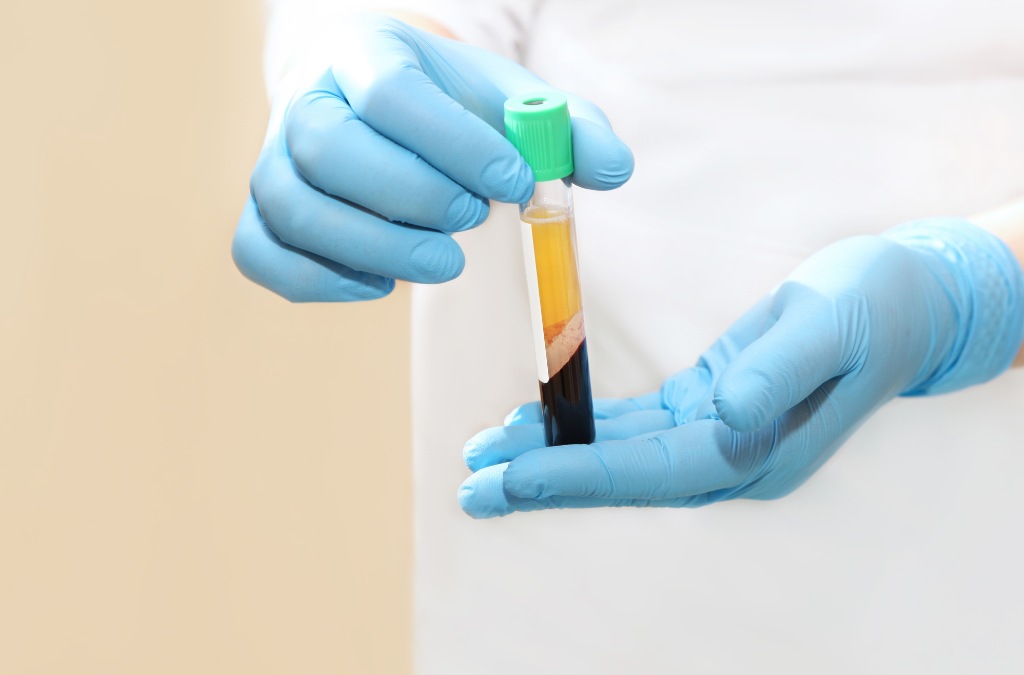Quick Takeaways
- PRP harnesses your body’s natural healing power.
- It accelerates tissue repair, reduces pain, and promotes regeneration.
- Widely used in sports medicine, especially for tendon and joint injuries.
Platelet Rich Plasma (PRP) therapy is a regenerative treatment that uses concentrated platelets from your own blood to speed up healing. A small sample of blood is drawn, spun in a centrifuge to separate the platelets, and then injected back into the injured area. These platelets are packed with growth factors, powerful proteins that drive tissue repair and regeneration.
For many athletes, PRP therapy benefits stem from its ability to bolster the body’s natural healing mechanisms without relying on external chemicals or drugs. By focusing on natural healing with PRP, patients can often sidestep the prolonged recovery times and potential complications of more invasive procedures.
History of PRP Therapy
Though PRP may feel like the newest buzz in sports rehabilitation, its roots date back to the 1970s when it was first explored in hematology. Over the past few decades, PRP therapy moved into the mainstream of orthopedics and sports medicine, gaining recognition for its capacity to heal injuries related to tendonitis treatment, ligament tears, and more. This timeline underscores the evolving nature of regenerative sports injury therapy and hints at even broader applications in the near future.
How Does PRP Work?
Understanding the scientific principles of PRP therapy is important to appreciate its effectiveness. The treatment works by harnessing the body’s natural healing mechanisms through a concentrated dose of platelets.
Mechanism of Action
At the heart of PRP therapy is the concept of supercharging your body’s intrinsic repair system. Once injected into the injured site, the concentrated platelets release a variety of growth factors and cytokines. These compounds attract cells responsible for rebuilding tissue, such as fibroblasts and stem cells, setting off a chain reaction of cellular healing. By localized delivery of these healing agents, PRP can help accelerate healing and enhance tissue quality in a more targeted way than conventional treatments.
Research indicates that injuries like partial ligament tears can benefit significantly from platelet rich plasma injection for sports injuries, where PRP’s potent concentration of growth factors can close the gap between minor injury and a full-blown surgical case.
Role of Growth Factors in Healing
- Platelet-Derived Growth Factor (PDGF): Prompts cell growth and division, boosting the formation of new tissue.
- Transforming Growth Factor-Beta (TGF-β): Encourages collagen production, a key component for strong and flexible tissues.
- Vascular Endothelial Growth Factor (VEGF): Fuels new blood vessel formation, ensuring the injured area receives ample blood supply for rapid recovery.
By orchestrating these molecular players, PRP therapy for tendon repair targets the root cause of injuries rather than just masking symptoms, offering a truly regenerative medicine approach.
Benefits of PRP Therapy
PRP therapy offers several key benefits that make it an attractive option for both patients and practitioners in sports medicine and beyond.
Healing Acceleration
The concentrated growth factors in PRP accelerate the body’s natural healing process. By boosting cell regeneration, patients often experience a quicker return to normal function and reduced downtime.
Pain Reduction
Many patients report a noticeable decrease in pain after PRP treatment. This reduction is attributed to both the anti-inflammatory properties of the growth factors and the accelerated tissue repair.
Tissue Regeneration
Beyond pain relief, PRP therapy actively promotes the regeneration of damaged tissues, which can lead to long-term improvements in joint function and mobility. This is especially beneficial for patients with chronic conditions such as osteoarthritis or persistent tendon injuries.
Common Uses of PRP in Sports Medicine
PRP therapy is especially popular in sports medicine, where rapid recovery is paramount. Here are some common applications:
Tendon Injuries
PRP injections are often used to treat tendonitis and chronic tendon injuries, providing targeted relief and promoting tissue regeneration where traditional treatments have failed.
Joint Pain and Osteoarthritis
Patients suffering from joint pain, especially in the knees and shoulders, benefit from PRP by experiencing reduced inflammation and improved joint mobility.
Muscle Injuries
Acute muscle strains or tears can also be treated with PRP, reducing recovery time and facilitating a quicker return to activity.
PRP Treatment Process
Understanding what to expect during a PRP treatment can alleviate any apprehensions. The process is straightforward and minimally invasive.
Consultation and Evaluation
Before undergoing PRP therapy, a thorough evaluation is conducted to determine if you’re a good candidate. This involves a detailed discussion of your medical history, current condition, and treatment goals.
Blood Draw and Centrifugation
A small amount of your blood is drawn and then spun in a centrifuge to separate the platelet-rich plasma from the rest of the blood components. This is the critical step that creates a concentrated solution packed with healing factors.
Injection Procedure
The prepared PRP is then injected directly into the injured area under guidance, often with ultrasound, to ensure precise delivery. The entire procedure typically takes less than an hour, and because it uses your own blood, the risk of adverse reactions is minimal.
Safety and Risks Associated with PRP
While PRP is generally considered safe, it is important to understand the potential risks and side effects.
Common Side Effects
Most patients experience only minor side effects, such as temporary pain or swelling at the injection site. These symptoms typically resolve within a few days.
Contraindications
PRP may not be suitable for everyone. For instance, individuals with certain blood disorders or active infections may not be ideal candidates. It’s essential to have a detailed consultation with your healthcare provider to discuss any potential risks.
Unlike many conventional treatments, PRP taps into the body’s own resources, offering a holistic and natural approach to healing that resonates with patients seeking alternatives to surgery or long-term medication.
PRP vs. Other Therapies
When considering treatment options, understanding how PRP stacks up against other therapies is crucial.
PRP vs. Steroid Injections
Steroid injections have long been a go-to for quick pain relief. However, they do little to foster actual tissue repair and may come with significant downsides when overused. Platelet rich plasma vs steroid injections is an increasingly common comparison, as PRP actively addresses the underlying issue by fueling tissue regeneration.
Clinical findings suggest that PRP therapy side effects are relatively minimal and primarily short-term, whereas steroids can accelerate tissue degeneration over time. For active individuals, PRP’s emphasis on genuine healing often outweighs the brief relief steroids might provide.
PRP vs. Surgery: A Non-Invasive Alternative
Surgery can be an effective solution for severe injuries but involves higher risks, longer recovery, and considerable expense. PRP therapy for ligament injuries offers a middle ground, aiming to heal tissues before surgical intervention becomes necessary. While PRP may not replace surgery for severe tears or complete ruptures, it can postpone or eliminate the need for invasive procedures in many cases.
For patients who prefer an effective PRP injection to address joint pain or tendon damage, this approach can be especially appealing. Fewer complications and a faster return to normal activities make PRP a top contender in regenerative sports injury therapy.
Future Trends in PRP Therapy
Current Studies and Breakthroughs
Ongoing research aims to refine PRP’s applications, exploring how different platelet concentrations or additive factors might further enhance healing. Recent studies published in the Journal of Orthopaedic Research suggest that higher platelet concentrations could yield faster recovery in tendon injuries, though optimal levels may vary by individual.
Additionally, there’s growing interest in combining PRP with stem cell therapies for a synergistic effect in repairing complex injuries. This merger points to a promising future for advanced sports medicine treatments using PRP, potentially expanding its role in injury management on a broader scale.
Future Trends in Regenerative Medicine
The horizon of regenerative medicine is rapidly evolving, with PRP at the forefront of this paradigm shift. Areas of active development include:
- Personalized PRP Formulations: Tailoring platelet concentrations to the patient’s specific injury.
- 3D Bioprinting and Tissue Engineering: Using PRP in scaffolds to promote better integration and faster healing.
- Expanded Application Fields: From spinal disc repair to advanced anti-aging treatments.
As the science matures, PRP may very well become a cornerstone of mainstream healthcare, delivering on its promise of natural healing with PRP and revolutionizing sports medicine in the process.
Preparing for a PRP Treatment Session
Proper preparation can significantly influence the success of your PRP therapy.
Pre-Treatment Guidelines
Before your session, you might be advised to avoid certain medications and activities that could affect blood clotting or inflammation. A detailed consultation will provide personalized instructions.
Post-Treatment Care
After the injection, rest and gradual reintroduction to activity are key. Follow-up appointments help track progress and make necessary adjustments to your recovery plan.
Frequently Asked Questions (FAQs)
What is platelet rich plasma?
Platelet rich plasma is a concentrated solution of platelets from your own blood, used to accelerate healing and tissue regeneration. It’s a non-surgical PRP treatment gaining popularity in sports medicine.
How long does it take to see results after a PRP injection?
Many patients report improvements within a few weeks, with full recovery varying based on the injury and treatment area. Studies have shown positive outcomes as early as 4-6 weeks.
Is PRP safe?
Yes, because PRP uses your own blood, the risk of allergic reactions or complications is minimal. However, proper screening and consultation are essential to ensure safety.
How does PRP compare with steroid injections?
Unlike steroid injections that offer temporary relief, PRP promotes tissue regeneration and offers longer-lasting benefits, making it ideal for chronic injuries and joint pain.
What should I do to prepare for a PRP treatment session?
Prior to treatment, you may need to adjust certain medications or activities. Your healthcare provider will give detailed pre-PRP treatment guidelines to maximize results.
In summary, Platelet Rich Plasma (PRP) therapy represents a significant leap forward in regenerative medicine. By leveraging the body’s own healing mechanisms, PRP not only accelerates recovery but also provides a natural and effective alternative to more invasive procedures. Throughout this article, we’ve explored the science behind PRP, its benefits in reducing pain and accelerating healing, and its diverse applications, from treating sports injuries to managing chronic joint pain. With its proven safety profile and evolving treatment protocols, PRP stands as a beacon of hope for patients seeking long-term relief and improved quality of life.
Reclaim Your Active Life With PRP in San Francisco
No one likes sitting on the sidelines, and with PRP therapy, you don’t have to. If you’re tired of endless recovery times, repeated steroid injections, or just not seeing progress with traditional therapies, it’s time to explore a more proactive approach. Avid Sports Medicine specializes in Platelet Rich Plasma treatments tailored to help you heal faster and stay in the game. Book your appointment today to see how PRP can transform your recovery and get you back to doing what you love, stronger, healthier, and sooner than you thought possible.

